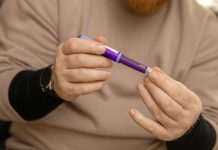
In a new study, researchers found that older adults who are classified as having “prediabetes” due to moderately elevated measures of blood sugar usually don’t go on to develop full-blown diabetes.
They followed nearly 3,500 older adults, of median age 76, for about six and a half years, and found that prediabetes is not a useful marker of diabetes risk in people of more advanced age.
The research was conducted by a team at Johns Hopkins.
The prevalence of diagnosed type 2 diabetes in the United States has gone from less than 1% in the 1950s to more than 7% today—and researchers believe that the actual figure now, including undiagnosed diabetes, is over 12%.
This sharp increase is due to the aging U.S. population and increased rates of overweight and obesity.
Doctors have used the concept of prediabetes—involving blood glucose levels that are higher than normal but not yet in the diabetic range—as an indicator of elevated diabetes risk in younger and middle-aged people.
However, the utility of the concept in older adults—especially those 70 and older—has been less clear.
In the study, the team analyzed data from 3,412 people who had attended a follow-up visit during 2011-13—a time when the participants were between 71 and 90 years old—and did not have any history of diabetes.
The researchers then looked at how measures of the participants’ blood glucose levels had changed at the next follow-up visit during 2016-17.
As expected, “prediabetes,” defined according to two different blood-test measures, was very common among the participants at the 2011-13 visit.
However, only a small number of the people who had prediabetes in 2011-13 had developed diabetes by the time of the 2016-17 visit—8% of the IFG (impaired fasting glucose test)-defined prediabetics, and 9% of the HbA1c-defined prediabetics.
By contrast, 44% of the IFG group and 13% of the HbA1c group had improved enough by the 2016-17 visit that their test results were back in the normal range.
Moreover, 16% and 19% of these two groups had died of other causes by the 2016-17 visit.
The results show that older adults with prediabetes, over intervals like the one in the study, are more likely to have lower blood sugar levels—or to die for other reasons—than to progress to diabetes.
The findings support a focus on lifestyle improvements, including exercise and diet when feasible and safe, for older adults with prediabetes.
The team recommends that for older adults, physicians should focus their screening efforts on risk factors, such as hypertension, that are more useful in predicting illness and mortality in this population.
One author of the study is Elizabeth Selvin, Ph.D., a professor in the Department of Epidemiology at the Bloomberg School.
The study is published in JAMA Internal Medicine.
Copyright © 2021 Knowridge Science Report. All rights reserved.



